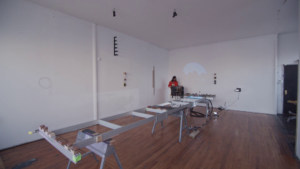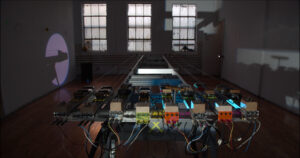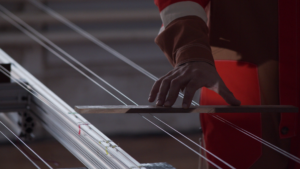By Daniel Fishkin
© all rights reserved. Printer friendly PDF version.
It’s March and I’m listening to my ears ringing in a very silent room.
I am in the Cooper Union Vibrations and Acoustics Lab, which houses what is reportedly New York City’s only anechoic chamber, a fact often touted by tour guides at the school, yet disputed by those in the know. These silence-loving experts might be right, or they might be confused, thinking of somewhere else: the gorgeous anechoic chamber at Nokia Bell Labs, Murray Hill campus. Of course, all anechoic chambers are special, but the Bell Labs Chamber is particularly memorable for its gigantic size. However, it is not in New York, but rather, New Jersey. In New York, the biggest city on the east coast of the USA, everything is small—Where you could fit a midsize orchestra in the silent room of Bell Labs, Cooper’s anechoic chamber could fit an intimate duet. Yet all anechoic chambers are special—they are veritable rumpus rooms for sounds to dance about without reverberation, a sandbox for composers to prototype music experiments, and well suited as a realm of quiet contemplation.
I’m sitting on an old piano bench, in front of a computer running some homebrew music software, where I’m adjusting bands of noise to match the ringing sounds in my ears. My routine in the chamber is simple—I begin by listening to nothing. After about 5 seconds or 10 minutes (depending on the day), from the silence emerges a curious harmony that only I can hear. The human hearing range is logarithmic, spanning 11 octaves, and it is in these last two octaves where my tinnitus is most active. Its swirling sound is not exactly a clear tone, but a kind of pitched noise, a hissing sibilance very high into my hearing range, between 8 and 14 kilohertz (kHz), though occasionally reaching as low as 6.5 kHz, or as high as 15kHz. After listening for a while, I try to figure out the frequencies by trial and error. I use filtered noise to try to match the ringing sound—and adjust the filters to match the coarse ranges that happen to be ringing that day. Sometimes it’s a specific note that I can whistle, and other times it’s a wide cluster, a band of frequencies that seethe indiscriminately.
I write down my findings, and convert the frequencies to musical notes, which I then notate on a musical staff, placed accordingly on a measure representing a 24-hour day. Today, between the hours of 5 and 7 pm, I heard the frequencies 10k and 12k very clearly, with 9k emerging by the last hour, so I notate the harmony in the third beat D-F# dyad, with the dissonant C# tied over on the next note. Just before leaving the chamber, I hear very clearly 7.6k, but I didn’t have time to write it down. But I hear it at my apartment later, so I jot down A# as the last beat, 10pm. It will be a completely different harmony the next day.
This project is called Tinnitus Journal. I want to continue it for year, and use the pitch journal as source material for music I haven’t been able to dream up yet.
I’ve had tinnitus since 2008 or so, and I dreamed of this specific project as early as 2010, though I didn’t have the listening chops or technical skill to pull it off. Instead, I composed music inspired by my tinnitus, and built musical instruments to accompany it—for the better part a decade. These instruments were all different versions of the same principle: I used very long piano wires, which I amplified with guitar pickups, and a novel feedback system I invented by connecting tactile transducers to wooden bridges, and sending the sound of the string back into itself until it vibrated and swelled of its own accord. I called it Lady’s Harp [Figures 1-4]. You can do lots of things with an instrument, but every time I played this instrument, it seemed to me that I was pursuing a very particular piece of music—certain ways of playing the strings didn’t work with this internal directive. Gradually, through testing it, I started to listen more and more to my ears ringing, and felt I had stumbled upon an instrument, finally, that I could set in dialogue with my hearing damage. Or, an instrument I could play that would not be out of tune— conceptually, acoustically—with my tinnitus.
This project, Composing the Tinnitus Suites (and my 20-foot-long Lady’s Harp), took up a lot of space in my life, figuratively, literally. It was loosely conceived as a yearly evolution of everything I did with the Lady’s Harp, as long as I could stage it so an audience could think about the poetics of hearing damage when confronting the work. The specifics, though, seemed out of reach at first. At the time, I couldn’t imagine a literal transcription of my tinnitus—it seemed like a logical fallacy, because I knew that my tinnitus was not, in fact, objective, but a neurological hallucination.
Just yesterday I was in the woodshop. I was sculpting more kinds of invented musical instruments made from wood, called daxophones, which I sell online to customers around the world. Those instruments don’t have anything to do with tinnitus. I do not hear my tinnitus there.
The whirring of the machines—the dust collector, the table saw, the sanders—is loud and enveloping, yet with my earplugs in, I am safe from the sound outside and the sound inside. Sometimes, it gets really, really loud, and I am careful, so I double up, wearing my noise-isolating headphones (‘gun muffs’) on top of my custom-molded earplugs. I have no idea how much sound this is actually blocking. The custom earplugs have 25-decibel (dB) filters, and the headset is rated for 30-dB cut, but that’s not how noise reduction works. I do know, though, what happens, if I turn the machines off and forget to take off the headphones, too. My tinnitus will come to visit me. It’s predictable—and it must resemble what happens in the case of severe noise-induced hearing loss. The brain, deprived of auditory stimulus via damaged stereocilia or excessive sound dampening, ‘turns up the volume’ to compensate for missing signals. But this will disappear when I take the earplugs out, and nourish my auditory cortex with sound again. So, I have no fear.
Back in the anechoic chamber, though, I hear my tinnitus—it just happens without mediation. There are countless articles and videos about anechoic chambers online. They are all the same. They have clickbait titles like ‘Can Silence Drive You Crazy?’ They warn equally of the dangers of gradual noise exposure, which is revealed by one’s tinnitus inside a chamber—and of the fearsome qualities of silence itself. I hate these scare tactics with a burning passion. Indeed, if you spent 45 minutes doing nothing in the Orfield Laboratories anechoic chamber of Minnesota, with its -9.4 dB background noise threshold, you might begin to hear your tinnitus, perhaps for the first time. But creative listeners can go to these places and do magical things. During my first visit to Bell Labs, a cellist was recording there. As soon as I walked in, I was struck by her quiet sound, which both saturated the silent room, yet remained fragile and delicate, like a ghost revealing its earthbound secrets. I stood all the way across the room and it sounded like my ear was right next to her soundboard. Give a creative musician the powerful tool of the silent room and they will make music with it.
Thus, I deplore the philistinism of any boring anechoic scolds, and their lack of imagination. But most critically, I hate the anechoic clickbait because it programs a conditioned response—if you expect to be afraid of silence, of your tinnitus, it will scare you. In fact, anyone is liable to hear their own signal in the quiet chapel of the chamber. This was proven at least twice: first, by John Cage’s experience in the anechoic chamber, where, when searching for silence, he found none, and thus confronted its impossibility; next, by the noted Heller-Bergman experiment of 1953, which placed one hundred ‘normally hearing’ people in an anechoic chamber, and asked them to describe the sounds they heard (Heller and Bergman 78). Over 90 percent of the subjects reported hearing ‘buzzing, humming, or ringing sounds’. The study suggests that tinnitus, the perception of sound without acoustic origin, is a basic property of the auditory system. But tinnitus clearly is a condition from which many people suffer—painfully. Media scholar Mack Hagood suggests that the ‘clarifying power of fear’ is an important mechanism by which tinnitus moves from being perceptual residue to diagnosis (Hagood). A tinnitus sufferer can worsen the perception of damage by focusing on it, and by worrying about it. In other words, having tinnitus is not just hearing your ears ringing, but fearing your ears ringing.
I practice Tinnitus Journal for a week, going to the chamber as much as I can manage. I am trying to become inspired again by my tinnitus, to play with it. When I began Composing the Tinnitus Suites, my manifesto at the time was: ‘I don’t want to get used to my hearing damage; I want to use it’ (Fishkin). In fact, since making Tinnitus Music, I suffer much less from my hearing—it provided a way to reinscribe my relationship with tinnitus in a productive way. I also live differently—I don’t play loud rock music. And, as a result, sometimes many weeks go without me noticing it. And when I do notice it, it’s like an old friend saying hello, or like divine inspiration. Today, I could say that using my tinnitus got me used to it. That isn’t to say that I don’t have profound moments of confusion, auditory dysphoria, semi-truck-horn induced hyperacusis, coffee-cup clinking-induced misophonia, unexplainable rage from someone whispering into my right ear, and of course, frequent disasters resultant from a lifetime in electronic music. But rather, that I take these moments in stride, and that I see them on a larger continuum of engaging with listening itself.
Yet, working on Tinnitus Journal has a completely different character from composing with the Lady’s Harp. I don’t see it as a piece of music in itself, but like a found object, a dead sea scroll that I can mine for information. I find my head full of harmonies, instead of focusing on the strings in front of me. I think of this time period as a rehearsal, to borrow a phrase from durational performance artist Tehching Hsieh, whose incredible pieces lasted a year at a time. Describing his process for ‘Rope Piece’, in which he was bound by lead-sealed rope to performance artist Linda Montano for a whole year, Hsieh explained:
I do not feel that the piece is dangerous. I have to know my limitations in a piece. So I do a rehearsal for a week to see what happens. I don’t want to do a piece that I feel is too risky—30% risk is okay. Accidents are possible in this piece, so we have to be very careful. (Grey and Grey)
Accidents, for Hsieh and Montano, might be an elevator door closing on the rope. I’m in the middle of my rehearsal for my own year-long performance, and I’m figuring out the limitations.
And, the dangers. After working on Tinnitus Journal for about a week, I don’t even need the anechoic chamber—I can hear my tinnitus in my apartment every night, suddenly, again. I hear it while I’m having normal conversations with people, and I get distracted by it, wondering what pitch it is. Now I am even able to hum the notes, octaves below, every time I hear it, and I’m starting to feel a little unhinged. Sometimes things get a little out of control with my ears—like, if I blast myself with a squall of feedback while working, I’ll deal with symptoms of tinnitus and sound fatigue for days, weeks even. But now the silence has gotten out of control—it’s the first time in a while that I feel trapped by my tinnitus. It seems that my experiment in the anechoic chamber unlocked an echo chamber in my head. But, what did I expect would happen? I shouldn’t be surprised. I knew that attention would train my powers of audition—and intensify the conditioned response of tuning into my tinnitus. I didn’t know, though, how quickly I might feel like I was “locked in” with my tinnitus all over again—how quickly that smile of my little tinnitus friend would turn menacing, and how sharp its Tee-ee-eeth.
Now it is September. Tinnitus Journal is waiting—perhaps not yet begun, perhaps unfinished… perhaps a suicidal idea in the first place. But I want to believe there’s a way for this project to breathe, a little more lightly. Some people hear the same notes every day with their tinnitus—I don’t. There must be a way to play with these daily harmonies, to understand them without them invading my perception, without them running wild. You see, there’s nothing objectionable about my tinnitus as material. I love—and I mean, love— sine waves, and pitched noise; and I love long durational music. And, I’m not one of those philistines who thinks certain dissonances should be avoided—any constellation of changing chords could delight me. If there’s anyone who could do, who could be captivated by their tinnitus on a daily basis, I thought it would be me. But I cannot do this project if it means losing control of the off-switch.
There’s got to be a way I can start, and finish, Journal. I just haven’t found it yet. But, I do know this: I have the rest of my life to find new ways to listen to it.
Daniel Fishkin, the composer and instrument builder, lives in Queens, NY (https://dfiction.com/).
Works Cited
Fishkin, Daniel. ‘Composing the Tinnitus Suites: 2008 Through 2016 (Until Death).’ Society of American Music Bulletin 42.3 (2016): 5-8. <https://cdn.ymaws.com/www.american-music.org/resource/resmgr/docs/bulletin/vol423.pdf>.
Grey, Alex, and Allyson Grey. ‘The Year of the Rope: An Interview with Linda Montano and Tehching Hsieh.’ High Performance Fall 1984.
Hagood, Mack. Hush: Media and Sonic Self-Control. Durham: Duke UP, 2019.
Heller, Morris F., and Moe Bergman. ‘Tinnitus Aurium in Normally Hearing Persons.’ Annals of Otology, Rhinology & Laryngology 62.1 (1953). <https://doi.org/10.1177/000348945306200107>.



